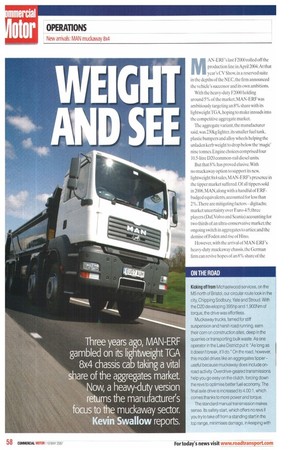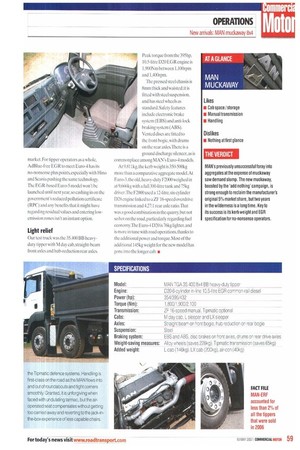WE GHT AtID SEE
Page 58

Page 59

If you've noticed an error in this article please click here to report it so we can fix it.
MAN-ERF's last F2000 rolled off the production line in April 2004. At that year's CV Show, in a reserved suite in the depths of the NEC. the firm announced the vehicle's successor and its own ambitions.
With the heavy-duty F2000 holding around 5% of the market, MAN-ERF was ambitiously targeting an 8% share with its lightweight TG A. hoping to make inroads into the competitive aggregate market.
The aggregate variant, the manufacturer said, was 230kg lighter,its smaller fuel tank, plastic bumpers and alloy wheels helping the unladen kerb weight to drop below the 'magic' nine tonnes. Engine choices comprised four 10.5-litre D20 common-rail diesel units.
But that 8% has proved elusive.With no muckaway option to support its new, lightweight 8x4 sales, MAN-ERF's presence in the tipper market suffered. Of all tippers sold in 2006. MAN, along with a handful of ERFbadged equivalents, accounted for less than 2%.There are mitigating factors — digitachs: market uncertainty over Euro-4/5: three players (DatVolvo and Scania) accounting for two thirds of an ultra-conservative market; the ongoing switch in aggregates to artics; and the demise of Foden and rise of Hino.
However, with the arrival of MAN-ERF's heavy-duty muckaway chassis, the German firm can revive hopes of an 8% share of the market. For tipper operators as a whole, AdBlue-free EGR to meet Euro-4 has its no-nonsense plus points, especially with Hino and Scani a pushing the same technology. The EGR-based Euro-5 model won't be launched until next year, so cashing in on the government's reduced pollution certificate (RPC) and any benefits that it might have regarding residual values and entering lowemission zones isn't an instant option.
Light relief
Our test truck was the 35.400 BB heavyduty tipper with M day cab. straight-beam front axles and hub-reduction rear axles. Peak torque from the 395hp, 10.5-litre D20 EGR engine is 1,900Nm between 1,100rpm and 1,400rpm.
The pressed steel chassis is 8mm thick and waisted; it is fitted with steel suspension, and has steel wheels as standard. Safety features include electronic brake system (EBS) and anti-lock braking system (ABS).
Vented discs are fitted to the front bogie, with drums on the rear axles.There is a ground discharge silencer, as is commonplace among MAN's Euro-4 models.
At 9.811kg, the kerb weight is 350-500kg more than a comparative aggregate model. At Euro-3. the old, heavy-duty F2000 weighed in at 9,666kg with a full 300-litre tank and 75kg driver.The F2000 used a 12-litre, six-cylinder 1)28 engine linked to a ZF 16-speed overdrive transmission and 4.27:1 rear axle ratio.That was a good combination in the quarry, but not so hot on the road.particularly regarding fuel economy.The Euro-4 D20 is 76kg lighter, and is more in tune with road operations, thanks to the additional power and torque.Most of the additional 145kg weight for the new model has gone into the longer cab.






















































































































































































